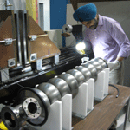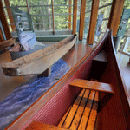

| Author Information - Paper preparation guidelines | |||||||||||||||
|
The deadline for the receipt of contributions to the Proceedings of SRF 2015 is: Wednesday, September 9 - 23:59 PDT (UT -0700)
Described below are some basic requirements for the preparation of contributions - more complete guidelines are provided in the text of our templates, available at the JACoW website. All contributions should be submitted via the Internet according to the Paper Submission instructions. Authors are reminded that, since no contributions are accepted for publication only, any paper accepted for presentation, which is not presented by one of the authors at the conference, will be excluded from the proceedings. Furthermore, the Scientific Program Committee reserves the right to refuse papers for publication which have not been properly presented in the poster sessions. Manuscripts of contributions to the proceedings (or enlargements of them) are not considered as posters and papers presented in this way will not be accepted for publication. JACoW Templates Contributions to the proceedings must be prepared using the JACoW templates, which were updated in 2014 and contain more detailed information to help authors submit their work for publication. These include templates for MSWord, LaTeX, and OpenOffice. Ensure that the template downloaded corresponds to the version of software you are using. Do not transport documents across different platforms e.g. Mac <-> PC or across different versions of Word on the same platform. The templates contain styles which, when applied, will automatically ensure correct typesetting and layout. Length of Contributions Papers for both contributed oral and poster presentation may be up to 5 pages long. Invited oral presentations may be up to 7 pages long. General Layout See the JACoW templates for a typical implementation of the requirements. Manuscripts should be prepared for the appropriate paper size and have:
The margins should be as follows:
Authors should use only Times or Times New Roman (in roman, bold or italic) and Symbol fonts. All contributions should use 10pt fonts for the normal text. Title The title should use 14 pt bold uppercase letters (except for instances such as GeV, Nb, etc.) and be centred on the page. Section Headings Section headings should use 12 pt bold uppercase letters (except for instances such as GeV, Nb, etc.) and be centred in the column. They should NOT be numbered. Subsection Headings Subsection headings should use 12 pt italic letters, be left aligned and justified in the column. As for section headings, they should NOT be numbered. Paragraph Text Paragraphs should use 10 pt font and be justified (touch each side) in the column. The beginning of each paragraph should be indented approximately 3 mm (0.13 in). The last line of a paragraph should not be printed by itself at the beginning of a column, nor should the first line of a paragraph be printed by itself at the end of a column. Figures, Tables and Equations Place figures and tables as close to the place of their first mention as possible. Lettering in figures and tables should be large enough to reproduce clearly, using only the approved fonts. Use of non-approved fonts in figures often leads to problems when the files are processed and may even cause loss of information, unless the fonts are embedded. To insert a full width figure:
If a displayed equation needs a number, place it flush with the right margin of the column. References All bibliographical and web references should be numbered and listed at the end of the paper in a section called "References". When citing a reference in the text, place the corresponding reference number in square brackets. A URL may be included as part of a reference, but its hyperlink should NOT be added. See the templates for a typical example. Acronyms Acronyms should be defined the first time they appear. Page Numbers DO NOT number pages. Page numbers will be added by the Editing Team when they produce the final proceedings. Paper Preparation Checklist
Once contributions are prepared, follow the Paper Submission instructions. Common Oversights Please check your paper against this list of common oversights before uploading it, giving particular attention to Figures, Tables and References. IS THE TITLE IN UPPERCASE? The title should use 14 pt bold UPPERCASE letters (except for units, e.g. GeV) and centred on the page. Authors The names of authors, their organizations/affiliations, and mailing addresses should be in 12 pt uppercase and lowercase letters. When there is more than one author, the submitting author should be first, followed by the co-authors. Co-authors should be grouped by affiliation and then be listed alphabetically. Primary authors are kindly reminded that it is their responsibility to check the accuracy of the title and co-authors entered in the SPMS abstract. There should be an exact match to those appearing in the paper. This is required to ensure the proper indexing of authors to papers in the published Proceedings. SECTION HEADINGS
Subsection Headings Subsection Headings use 12 pt italic lowercase and uppercase. The initial letters of significant words are capitalized, and the heading is left aligned in the column. Figures Figure captions should be placed below the figure and centred if on one line, but justified if spanning two or more lines: Figure 1: A one line figure caption. Figure 2: A figure caption that takes two lines or Note the colon ":" after the figure number and the period "." at the end of the caption. When referring to a figure from within the text, the convention is to use the abbreviated form, i.e. Fig. 1, unless the reference to the figure is at the start of the sentence: Figure 1 shows a schematic view of ... as shown in Fig. 1. Tables Table Headings should be placed above the table and centred if on one line, but justified if spanning two or more lines: Table 1: Table Heading Table 1: A Particularly Long Table Heading Spanning Note the colon ":" after the table number, initial letters of the Table Heading are capitalized, and the absence of a period at the end of the caption. It is also acknowledged, however, that in some instances authors find it necessary to replace the table heading with an actual sentence. In such a case, the formatting rules given for figure captions are best followed. The table caption should, however, always be placed above the table. When referring to a table from within the text, the convention here is NOT to abbreviate, i.e. Table 1. Equations If a displayed equation requires a number, it should be placed flush with the right margin of the column. References References are written in 10 pt and should be justified with 0.25 in (7 mm) hanging indent (using Word terminology) i.e. neatly presented with reference numbers aligned. SPMS data will be used for the production of the table of contents and author index of the proceedings. Failure to enter all co-authors means they will be omitted from the author index. |
 |
 |
 |
 |
 |
| Sponsors |